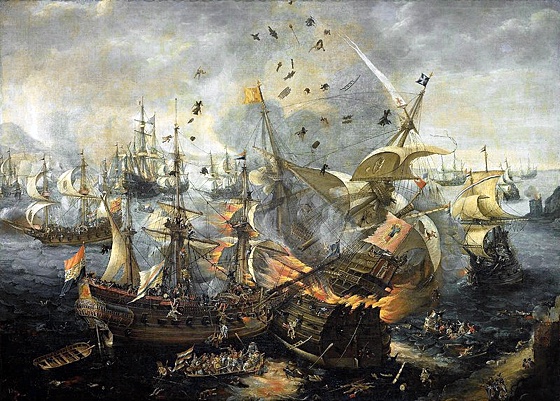
The countercultural mode of the 1960s-80s marked the final attempts to rescue the glory of systems from the maw of nihilistic collapse. It failed, and we live in its wreckage.
It would be polite to say “enduring influence” but I’d rather call it “wreckage.” As civilization burned, we built two vast, fantastical, ornate galleons as escape ships. But they were not the slightest bit sea-worthy; and they collided and broke up in the harbor. The crash left a floating mass of broken spars and tangled lines, choking access to the exit.
Millions of people are still trying to live on that flotsam, so you call across: “It’s a pile of water-logged junk; the rest will sink soon; why don’t you come join us in our fleet of nimble new watercraft?” They jeer that your pathetic little boats are made of plastic, and you say “it’s not plastic, it’s a kevlar composite kayak,” and so on.
This is a metaphor for the development of modes of meaningness over the past half-century. “Kayaks” will become clear only when I get to the fluid mode. But let’s talk galleons: the two countercultures.
I define the countercultural mode of meaningness as:
Developing a new, alternative, universalist, eternalist, anti-rational system for society, culture, and self, meant to replace the mainstream.
I discuss two movements that fit this definition: the “hippie” counterculture of the 1960s-70s, and the “Moral Majority” counterculture of the 1970s-80s.1
Goals for this discussion
The content of the countercultures is still all around us: rock concerts and televangelists, for instance. Such content is familiar to everyone, and needs no review.
The structure and function of the countercultures may be less understood. What problems did they address, and how were their solutions supposed to work? In what ways did they succeed and fail, and why? That is my topic here.
One goal is to understand the continuing influence of the countercultures, and especially the way their “culture war” has polarized Western societies. I will suggest that much of this polarization is due to a pervasive misunderstanding of the structure and function of the countercultures. Better understanding might help heal the rift. The two had much more in common than they recognized—both in terms of what was right about them, and what was wrong. They were both good-faith attempts to rescue systematic eternalism, using similar methods. That was impossible, however, and they both failed for the same reasons.
The following mode, the subcultural mode, can only be analyzed as a response to countercultural failure—so the failure must be understood. The subcultural and atomized modes also failed, so we still have most of the same problems—but in different forms, because each mode has transformed meaningness in its own way.
The countercultural mode is “native” only for the Baby Boom generation. It is very different from the subcultural and atomized modes, native to Generations X and Y. One goal of this whole history of meaningness is to help give people in each generation access to each other’s way of processing meaning.
Overview of the section
I’ll begin by expanding on the definition “new, alternative, universalist, eternalist, anti-rational systems,” showing how the two countercultures fit each part of that.
“The counterculture” generally refers to the youth movement of the 1960s to early 1970s. The idea that the American “Christian conservative” movement of the late 1970s and 1980s was also a counterculture may seem implausible at first. It does fit that definition, however.
I will suggest that the two countercultures are best understood as monist and dualist, respectively. You might call them “leftist” and “rightist,” but those words are not well-defined. In fact, “left” and “right” changed their meanings during the countercultural era, in what I will describe as a “ninety degree clockwise rotation.”
Both countercultures attempted to address the problems of meaningness caused by the failure of the systematic mode during the first half of the 20th century. Although the content of their proposed solutions were often opposed, the structure was the same. Both attempted to create a new, optimistic, revitalized systematicity, by rejecting rationality and developing new religious technologies of the self. Both sought to reform society by collapsing the distinction between the personal and the political.
Both countercultures used the time distortion tricks of “invented traditions” and “timeworn futures” to make their dubious proposals seem more attractive. The “hippie” counterculture pretended to be progressive, but mainly recycled early-1800s Romanticism; the “Moral Majority” counterculture pretended to be traditional, but had a radical modern agenda. These deliberate deceptions account for some of the acrimony of the culture war.
Although both countercultures developed impressively thick and wide approaches to problems of meaning, both failed, for the same reason. Systematicity can never succeed on its own terms; it cannot be absolute. Reality is nebulous, and systems cannot fully grasp its variability. The universalism of the countercultures was their undoing. They could not accommodate the growing demand for cultural, social, and psychological diversity. Subcultures could, and did.
I find understanding the countercultures as monist and dualist helpful, in the light of my earlier analysis of what is right and wrong in these two stances, and how the correct aspects of each can be combined and reconciled in the complete stance of participation. This suggests ways the “left vs. right” polarization of current politics, culture, and society might also be resolvable.
The countercultures were the two final attempts to rescue eternalism: the last gasp of modernity. The following, subcultural mode was the first in-breath of the post-systematic—or post-modern—world.
- 1.Some earlier movements might also fit this definition; for instance Romanticism and existentialism. Socialism would fit except it was rationalist; fascism would fit except it was non-universalist. All four of these fed into the 60s-80s movements. I concentrate on the 60s-80s because my goal is to understand the most direct influences on our current mode of meaningness, rather than developing a general theory of history. Islamic fundamentalism is also mainly countercultural; I will return to this point later in the history.
